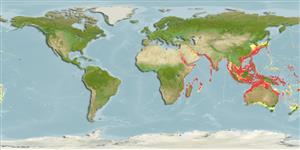Common names from other countries
Classification / Names / Names
Common names | Synonyms | Catalog of Fishes (gen., sp.) | ITIS | CoL | WoRMS
Environment: milieu / climate zone / depth range / distribution range
Ecology
Benthic; depth range 0 - 610 m (Ref. 89006). Temperate
Indo-West Pacific: from East Africa, including Madagascar, to Melanesia; north to the Philippines and south to Queensland, New Caledonia and New Zealand.
Length at first maturity / Size / Weight / Age
Maturity: Lm ? range ? - ? cm Max length : 8.0 cm SHH male/unsexed; (Ref. 348); common length : 6.0 cm SHH male/unsexed; (Ref. 348)
Shell solid, medium sized, higher than long and rounded-ovate in outline. Both valves convex and subequal, the right (lower) valve a little flatter than the left (upper) valve. Ears markedly unequal in size, the anterior ones more than twice the length of the posterior ones. Ventral side of right anterior ear with a deep byssal notch and a ctenolium. Main sculpture of each valve of 20 to 26 rounded often with fine secondary radial threads, and with microscopic lines, obliquely diverging on anterior and posterior sides of valves. Ears strongly ribbed, the dorsalmost rib of right anterior ear somewhat protruding and adorned with erect spines. Interior shiny, with low, rounded radial ribs corresponding to the outer sculpture. Colour: outside of shell variable, dull purple, brown or orange, frequently variegated with paler blotches. Interior similarly coloured, suffused with white on hinge and umbonal cavity.
Life cycle and mating behavior
Maturity | Reproduction | Spawning | Eggs | Fecundity | Larvae
Members of the class Bivalvia are mostly gonochoric, some are protandric hermaphrodites. Life cycle: Embryos develop into free-swimming trocophore larvae, succeeded by the bivalve veliger, resembling a miniature clam.
Spurgeon, A. 2007. (Ref. 8121)
IUCN Red List Status (Ref. 130435: Version 2024-1)
CITES status (Ref. 108899)
Not Evaluated
Not Evaluated
Human uses
Fisheries: commercial
| FishSource | Sea Around Us
Tools
Internet sources
Estimates based on models
Preferred temperature
(Ref.
115969): 12.7 - 26.7, mean 19.9 (based on 877 cells).
Resilience
High, minimum population doubling time less than 15 months (K=0.46-0.65).
Vulnerability
Low to moderate vulnerability (29 of 100).
